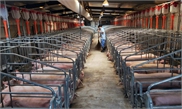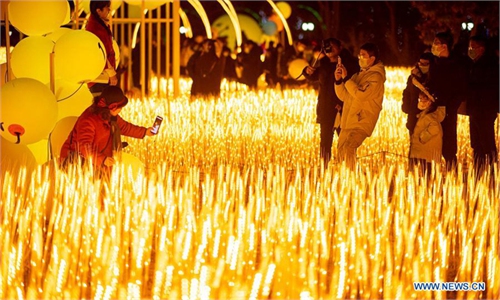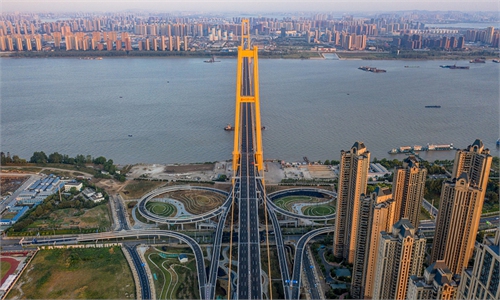Hubei Province's 2021 GDP growth rate expected to surpass 15%
People and companies in COVID-stricken province crash the schedule
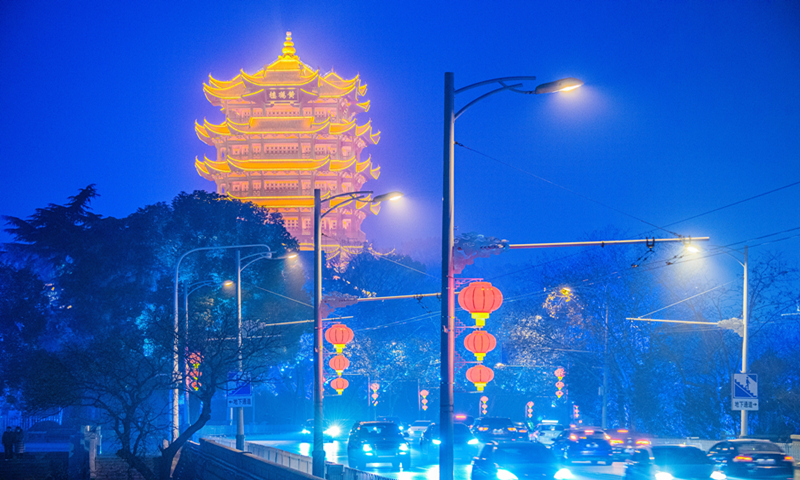
Red lanterns are hung in the streets of Wuhan, capital of Central China's Hubei Province, for the upcoming Spring Festival which falls on February 12, 2021. Photo: VCG
Hu Junhua is a crawfish farmer in Qianjiang, Hubei Province in Central China, who has witnessed how the most representative farming sector shook off the impact of the coronavirus outbreak.
"I became extremely worried in February 2020 when it was time to put the crawfish fry into the paddy fields and catch the mature ones for sale," he said, noting that village roads were blocked, so they couldn't get the fish feed necessary for crawfish farming.
Thanks to the government's favorable policies to grant farmers and feed suppliers special green passes to resume operations in tandem with the country's booming livestreaming e-commerce, the crawfish farming quickly resumed, Hu told the Global Times, adding that there are special 24-hour logistics channels facilitating crawfish shipping in Qianjiang.
Livestreaming e-commerce has helped local merchants greatly after the virus outbreak. For instance, Chinese livestreaming icon Viya has helped companies in Hubei sell more than 250 million yuan ($38.57 million) of products in 2020, including popular local food such as crawfish and local delicacy - hot dry noodle, according to statistics provided by Viya's team to the Global Times.
"In 2020, almost 80-90 percent crawfish farmers suffered a loss because of the lockdown in spring, but the industry is rapidly healing - the price is rising and many farmers have improved nurturing methods to grow relatively bigger crawfish and rake in more profits," Hu said, adding that he forecasts a bump harvest in 2021.
The comeback of Qianjiang crawfish farming is one example of how the local industries have recovered from the coronavirus fallout in Hubei. More importantly, the havoc generated rising diligence on the part of factory workers in the province, which is now striving to catch up with other provinces and cities.
Setting the stage for substantial growth this year, Hubei has set its GDP growth target for 2021 at more than 10 percent, as announced in a local government work report on Sunday.
Playing catch-up
"Every night when I drop by office buildings on my way home in Wuhan, all of the lights inside the buildings are brightly lit. Companies in most industries are putting in extra hours in order to get up to speed with other parts of China," a Wuhan-based white-collar worker surnamed Li told the Global Times.
He said from a personal perspective, employees work harder to make up for the loss in their savings, and for companies and factories which were shut down for almost three months last year they are trying their best to play catch-up.
"While lifestyle, consumption and working habits are all changing following the virus outbreak in Hubei, me and my friends are working harder with a fighting spirit," Li said.
Host to a number of high-tech manufacturing companies, such as chip and printed-circuit board producers, Hubei witnessed the value-added of such industries growing by 4.1 percent in 2020 compared with the previous year, in contrast with the value-added of the province's large industrial enterprises which plunged 6.1 percent year-on-year.
As an example, Wuhan Guide Infrared, one of the leading suppliers of infrared thermal imaging products in China, has seen its exports surge since last May, with international turnover doubling in 2020 compared with 2019, Sally Gao, a sales manager at the company told the Global Times.
"The booming market demand required our factories to operate around the clock on three shifts. Our workers crashed the schedule from last February to September," Sally said.
Since last February, the company's capacity has grown 50 percent, with bigger annual goal setting at an increase of 40 percent in turnover this year, according to Sally.
The automobile manufacturing sector was one of the hard-hit industries at the beginning of last year in Hubei. Virus containment measures, disrupted supply of auto parts, factory shutdowns and stranded workers put for a huge strain on local auto enterprises.
However, with a fighting spirit and efforts to drive up the resumption of auto industrial chains, suppliers and car dealers, auto makers in Hubei actively took self-rescue measures.
DongFeng Motor Corporation brought the first batch of its employees back to Wuhan on March 21, 2020 in line with the gradually contained epidemic situation at that time. The company's resumption drove more than 2,700 car dealers and suppliers - around 220,000 workers - to return to work.
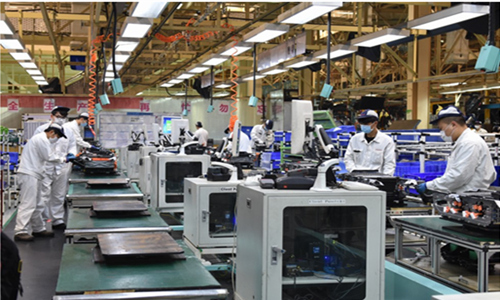
DongFeng Motor Corporation leads in work resumption in Central China's Hubei Province in 2020. Photo: Courtesy of DongFeng Motor Corporation
Wuhan Bus manufacturing Co produced its first COVID-19 testing mobile vehicle last November and has commenced bulk sales of the special vehicle.
"Hubei 'caught a cold' but it has recovered quickly," Chen Chunxing, deputy president of the Hubei Federation of Industry and Commerce, told the Global Times, stressing that the province's economy will expand in 2021.
"After the coronavirus outbreak, I saw more vitality and greater passion from local entrepreneurs. More talent began to flow back to Hubei, which Hubei hopes for," Chen noted, predicting the province's GDP growth is likely to hit 15 percent this year.
With a thriving atmosphere and the hard-working spirit of local people and local enterprises, the economy of Hubei Province contracted 5 percent last year to 4.34 trillion yuan, but all major indicators have pointed to a roaring recovery as local consumption returned to growth in December.
The rate of economic decline narrowed quickly from the first-quarter figure of a massive 39.2 percent plunge, when the provincial capital Wuhan experienced a stringent 76-day lockdown.
Achieving such results is positive as Hubei only worked for half a year in 2020, Dong Dengxin, director of the Financial Securities Institute at Wuhan University of Science and Technology, told the Global Times.
Looking into 2021, Dong said that stabilizing employment and reviving local consumption are the two biggest challenges.
According to statistics by Trip.com Group, China's largest online travel agency, tourists visiting Hubei last August tripled after the province allowed trans-provincial group tours.
